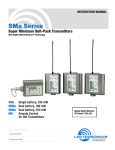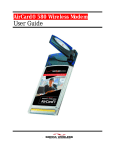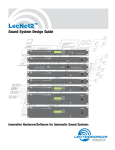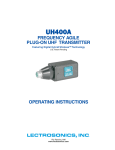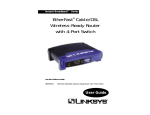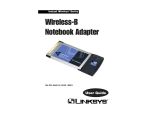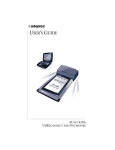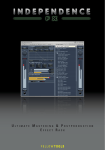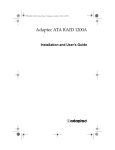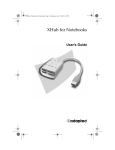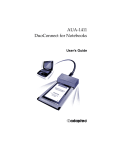Download Adaptec Ultra Wireless Wireless Access Point User's Manual
Transcript
Adaptec Ultra WirelessTM Access Point User’s Guide R Copyright © 2002 Adaptec, Inc. All rights reserved. No part of this publication may be reproduced, stored in a retrieval system, or transmitted in any form or by any means, electronic, mechanical, photocopying, recording or otherwise, without the prior written consent of Adaptec, Inc., 691 South Milpitas Blvd., Milpitas, CA 95035. Trademarks Adaptec, the Adaptec logo, and Ultra Wireless are trademarks of Adaptec, Inc., which may be registered in some jurisdictions. Windows 98SE, Windows Me, Windows 2000, and Windows XP, are trademarks of Microsoft Corporation in the US and other countries, used under license. All other trademarks are the property of their respective owners. Changes The material in this document is for information only and is subject to change without notice. While reasonable efforts have been made in the preparation of this document to assure its accuracy, Adaptec, Inc. assumes no liability resulting from errors or omissions in this document, or from the use of the information contained herein. Adaptec reserves the right to make changes in the product design without reservation and without notification to its users. Disclaimer IF THIS PRODUCT DIRECTS YOU TO COPY MATERIALS, YOU MUST HAVE PERMISSION FROM THE COPYRIGHT OWNER OF THE MATERIALS TO AVOID VIOLATING THE LAW WHICH COULD RESULT IN DAMAGES OR OTHER REMEDIES. ii Adaptec Technical Support If you have questions about installing or using your Adaptec product, check this document first—you will find answers to most of your questions here. If you need further assistance, use the support options listed below. Technical Support Identification (TSID) Number ■ ■ Before contacting Technical Support, you need your unique 12-digit TSID number. The TSID number identifies your product and support status. The TSID number is included on two white, bar-coded labels, like the example below. Support Options ■ ■ Search the Adaptec Support Knowledgebase (ASK) at ask.adaptec.com for articles, troubleshooting tips, and frequently asked questions for your product. For support via Email, submit your question to Adaptec's Technical Support Specialists at ask.adaptec.com. ■ To order Adaptec products, including accessories and cables, call +1 408-957-7274. Or, you can order cables online at www.adaptec.com/buy-cables. Europe ■ ■ ■ Visit our Web site at www.adaptec-europe.com. German and English: Search the Adaptec Support Knowledgebase (ASK) at ask-de.adaptec.com for articles, troubleshooting tips, and frequently asked questions for your product. For support via e-mail, submit your question to Adaptec's Technical Support Specialists at ask-de.adaptec.com. French: Search the Adaptec Support Knowledgebase (ASK) at ask-fr.adaptec.com for articles, troubleshooting tips, and frequently asked questions for your product. For support via e-mail, submit your question to Adaptec's Technical Support Specialists at ask-fr.adaptec.com. ■ To order Adaptec products, including accessories and cables, go to www.adaptec.com/buy-cables. Australia and New Zealand ■ ■ Visit our Web site at www.adaptec.com.au. For support via e-mail, submit your question to Adaptec's Technical Support Specialists at ask.adaptec.com. Hong Kong and China ■ ■ Visit our Web site at www.adaptec.com. Fax Technical Support at +852 2869 7100. Singapore ■ Visit our Web site at www.adaptec.com. Japan ■ ■ Search the Adaptec Support Knowledgebase (ASK) at ask.adaptec.co.jp Visit our Web site at www.adaptec.co.jp. iii Limited 2-Year Hardware Warranty 1. Adaptec, Inc. (“Adaptec”) warrants to the purchaser of this product that it will be free from defects in material and workmanship for a period of two (2) years from the date of purchase. If the product should become defective within the warranty period, Adaptec, at its option, will repair or replace the product, or refund the purchaser’s purchase price for the product, provided it is delivered at the purchaser’s expense to an authorized Adaptec service facility or to Adaptec. 2. Repair or replacement parts or products will be furnished on an exchange basis and will either be new or reconditioned. All replaced parts or products shall become the property of Adaptec. This warranty shall not apply if the product has been damaged by accident, misuse, abuse or as a result of unauthorized service or parts. 3. Warranty service is available to the purchaser by delivering the product during the warranty period to an authorized Adaptec service facility or to Adaptec and providing proof of purchase price and date. The purchaser shall bear all shipping, packing and insurance costs and all other costs, excluding labor and parts, necessary to effectuate repair, replacement or refund under this warranty. 4. For more information on how to obtain warranty service, write or telephone Adaptec at 691 South Milpitas Boulevard, Milpitas, CA 95035, (800) 959-7274. 5. THIS LIMITED WARRANTY DOES NOT EXTEND TO ANY PRODUCT WHICH HAS BEEN DAMAGED AS A RESULT OF ACCIDENT, MISUSE, ABUSE, OR AS A RESULT OF UNAUTHORIZED SERVICE OR PARTS. 6. THIS WARRANTY IS IN LIEU OF ALL OTHER EXPRESS WARRANTIES WHICH NOW OR HEREAFTER MIGHT OTHERWISE ARISE RESPECT TO THIS PRODUCT. IMPLIED WARRANTIES, INCLUDING THOSE OF MERCHANTABILITY, FITNESS FOR A PARTICULAR PURPOSE AND NON-INFRINGEMENT SHALL (A) HAVE NO GREATER DURATION THAN 2 YEARS FROM THE DATE OF PURCHASE, (B) TERMINATE AUTOMATICALLY AT THE EXPIRATION OF SUCH PERIOD AND (C) TO THE EXTENT PERMITTED BY LAW BE EXCLUDED. IN THE EVENT THIS PRODUCT BECOMES DEFECTIVE DURING THE WARRANTY PERIOD, THE PURCHASER’S EXCLUSIVE REMEDY SHALL BE REPAIR, REPLACEMENT OR REFUND AS PROVIDED ABOVE. INCIDENTAL OR CONSEQUENTIAL DAMAGES, INCLUDING WITHOUT LIMITATION LOSS OF DATA, ARISING FROM BREACH OF ANY EXPRESS OR IMPLIED WARRANTY ARE NOT THE RESPONSIBILITY OF ADAPTEC AND, TO THE EXTENT PERMITTED BY LAW, ARE HEREBY EXCLUDED BOTH FOR PROPERTY DAMAGE, AND TO THE EXTENT NOT UNCONSCIONABLE, FOR PERSONAL INJURY DAMAGE. 7. SOME STATES DO NOT ALLOW THE EXCLUSION OR LIMITATION OF INCIDENTAL OR CONSEQUENTIAL DAMAGES FOR CONSUMER PRODUCTS, AND SOME STATES DO NOT ALLOW LIMITATIONS ON HOW LONG AN IMPLIED WARRANTY LASTS, SO THE ABOVE LIMITATION OR EXCLUSIONS MAY NOT APPLY TO YOU. 8. This warranty gives you specific legal rights, and you may also have other rights which vary from state to state. iv Adaptec Software License Agreement PLEASE READ CAREFULLY: THE USE OF THIS SOFTWARE IS SUBJECT TO THE SOFTWARE LICENSE TERMS OF ADAPTEC, INC. AND OTHER LICENSORS WHOSE SOFTWARE MAY BE BUNDLED WITH THIS PRODUCT. BY YOUR USE OF THE SOFTWARE INCLUDED WITH THIS PRODUCT YOU AGREE TO THE LICENSE TERMS REQUIRED BY THE LICENSOR OF THAT SOFTWARE, AS SET FORTH DURING THE INSTALLATION PROCESS. IF YOU DO NOT AGREE TO THE LICENSE TERMS APPLICABLE TO THE SOFTWARE, YOU MAY RETURN THE ENTIRE UNUSED PRODUCT FOR A FULL REFUND. In return for acquiring a license to use the Adaptec software (“Software”) and the related documentation, you agree to the following terms and conditions: 1. License. This Agreement grants you, the Licensee, a license to: a. Use the Software on a single computer system or on multiple workstations, systems and servers which incorporate an Adaptec RAID controller and may be accessed by multiple users from multiple locations. You may make as many installations of the Software as needed, but must restrict such installation only to systems, workstations or servers using an Adaptec RAID controller. b. Make one copy of the Software in machine readable form solely for back-up purposes provided you reproduce Adaptec’s copyright notice and any proprietary legends. 2. Restrictions. You may not distribute copies of the Software to others. You may not post or otherwise make available the Software, or any portion thereof, in any form, on the Internet. You may not use the Software in a computer service business, including in time sharing applications. The Software contains trade secrets and, in order to protect them, you may not decompile, reverse engineer, disassemble, or otherwise reduce the Software to a humanperceivable form. YOU MAY NOT MODIFY, ADAPT, TRANSLATE, RENT, LEASE, LOAN, RESELL FOR PROFIT, DISTRIBUTE, NETWORK OR CREATE DERIVATIVE WORKS BASED UPON THE SOFTWARE OR ANY PART THEREOF. 3. Ownership of Software. As Licensee, you own the media upon which the software is recorded or fixed, but Adaptec and its licensors retain title and ownership of the Software recorded on the original media and all subsequent copies of the Software, regardless of the form or media in which or on which the original and other copies may exist. This license is not a sale of the Software or any copy. 4. Confidentiality. You agree to maintain the Software in confidence and that you will not disclose the Software to any third party without the express written consent of Adaptec. You further agree to take all reasonable precautions to preclude access of unauthorized persons to the Software. 5. Term. This license is effective until January 1, 2045, unless terminated earlier. You may terminate the license at any time by destroying the Software (including the related documentation) together with all copies or modifications in any form. Adaptec will have the right to terminate our license immediately if you fail to comply with any term or condition of this Agreement. Upon any termination, including termination by you, you must destroy the Software (including the related documentation), together with all copies or modifications in any form. 6. Special Terms Applicable to Databases. Where a database is included with the Software, you acknowledge that it is licensed only in connection with the use of the Software to perform disc creation, and that the database and all data derived therefrom must be maintained in confidence in accordance with the provisions of Section 4. This license does not grant you any rights to distribute or disclose such database or data. v 7. Limited Warranty. Adaptec and its Licensor warrant only that the media upon which the Software is furnished will be free from defects in material or workmanship under normal use and service for a period of thirty (30) days from the date of delivery to you. ADAPTEC AND ITS LICENSORS DO NOT AND CANNOT WARRANT THE PERFORMANCE OR RESULTS YOU MAY OBTAIN BY USING THE SOFTWARE OR DOCUMENTATION. THE FOREGOING STATES THE SOLE AND EXCLUSIVE REMEDIES ADAPTEC AND ITS LICENSORS WILL PROVIDE FOR BREACH OF WARRANTY. EXCEPT FOR THE FOREGOING LIMITED WARRANTY, ADAPTEC AND ITS LICENSORS MAKE NO WARRANTIES, EXPRESSED OR IMPLIED, INCLUDING, BUT NOT LIMITED, AS TO NON-INFRINGEMENT OF THIRD PARTY RIGHTS, MERCHANTABILITY OR FITNESS FOR A PARTICULAR PURPOSE. Some states do not allow the exclusion of implied warranties or limitations on how long an implied warranty may last, so the above limitations may not apply to you. This warranty gives you specific legal rights and you may also have other rights which vary from state to state. 8. The entire liability of Adaptec and its licensors, and your exclusive remedy for a breach of this warranty, shall be: a. The replacement of any media not meeting the above limited warranty which is returned to Adaptec; or: b. If Adaptec or its distributor is unable to deliver replacement media which is free from defects in materials or workmanship, you may terminate this Agreement by returning the Software and your money will be refunded. 9. Limitation of Liability. IN NO EVENT WILL ADAPTEC OR ITS LICENSORS BE LIABLE TO YOU FOR ANY INCIDENTAL, CONSEQUENTIAL OR INDIRECT DAMAGES, INCLUDING ANY LOST PROFITS, LOST SAVINGS, OR LOSS OF DATA, EVEN IF ADAPTEC OR A LICENSOR HAS BEEN ADVISED OF THE POSSIBILITY OF SUCH DAMAGES, OR FOR ANY CLAIM BY ANY OTHER PARTY. Some states do not allow the exclusion or limitation of special, incidental, or consequential damages, so the above limitation or exclusion may not apply to you. 10. Export. You acknowledge that the laws and regulations of the United States and other countries may restrict the export and re-export of the Software. You agree that you will not export or re-export the Software or documentation in any form in violation of applicable United States and foreign law. 11. Government Restricted Rights. The Software is subject to restricted rights as follows. If the Software is acquired under the terms of a GSA contract: use, reproduction or disclosure is subject to the restrictions set forth in the applicable ADP Schedule contract. If the Software is acquired under the terms of a DoD or civilian agency contract, use, duplication or disclosure by the Government is subject to the restrictions of this Agreement in accordance with 48 C.F.R. 12.212 of the Federal Acquisition Regulations and its successors and 49 C.F.R. 227.7202-1 of the DoD FAR Supplement and its successors. 12. General. You acknowledge that you have read this Agreement, understand it, and that by using the Software you agree to be bound by its terms and conditions. You further agree that it is the complete and exclusive statement of the agreement between Adaptec and you, and supersedes any proposal or prior agreement, oral or written, and any other communication between Adaptec and you relating to the subject matter of this Agreement. No additional or any different terms will be enforceable against Adaptec unless Adaptec gives its express consent, including an express waiver of the terms of this Agreement, in writing signed by an officer of Adaptec. You assume full responsibility for the use of the Software and agree to use the Software legally and responsibly. This Agreement shall be governed by California law, except as to copyright matters, which are covered by Federal law. This Agreement is deemed entered into at Milpitas, California by both parties. Should any provision of this Agreement be declared unenforceable in any jurisdiction, then such provision shall be deemed severable from this Agreement and shall not affect the remainder hereof. All rights in the Software not specifically granted in this Agreement are reserved by Adaptec. Should you have any questions concerning this Agreement, you may contact Adaptec by writing to: Adaptec, Inc. Legal Department 691 South Milpitas Boulevard Milpitas, California 95035. vi Regulatory Compliance Statements Federal Communications Commission Radio Frequency Interference Statement WARNING: Changes or modifications to this unit not expressly approved by the party responsible for compliance could void the user’s authority to operate the equipment. This equipment has been tested and found to comply with the limits for a Class B digital device, pursuant to Part 15 of the FCC rules. These limits are designed to provide reasonable protection against harmful interference in a residential installation. This equipment generates, uses, and can radiate radio frequency energy, and if not installed and used in accordance with the instructions, may cause harmful interference to radio communications. However, there is no guarantee that interference will not occur in a particular installation. If this equipment does cause harmful interference to radio or television reception, which can be determined by turning the equipment off and on, the user is encouraged to try to correct the interference by one or more of the following measures: ■ Reorient or relocate the receiving antenna. ■ Increase the separation between equipment and receiver. ■ Connect the equipment to an outlet on a circuit different from that to which the receiver is connected. ■ Consult the dealer or an experienced radio/television technician for help. You are cautioned that changes or modifications not expressly approved by the part responsible for compliance could void your authority to operate the equipment. Adaptec, Inc. AWN-8060 Tested to Comply With FCC Standards FOR HOME OR OFFICE USE Federal Communications Commission (FCC) Radiation Exposure Statement This equipment complies with FCC radiation exposure limits set forth for an uncontrolled environment. This equipment should be installed and operated with a minimum distance of 20 cm between the radiator and your body. CE Mark Warning This is a Class B product. In a domestic environment, this product may cause radio interference, in which case the user may be required to take adequate measures. This transmitter must not be co-located or operated in conjunction with any other antenna or transmitter. Canadian Compliance Statement This Class B digital apparatus meets all requirements of the Canadian InterferenceCausing Equipment Regulations. Cet appareil numérique de la classe B respecte toutes les exigences du Règlement sur le matériel brouilleur du Canada. vii In this Guide Introduction 2 Installation Task List 3 Installing Your Wireless AP 6 Installing the Wireless Access Point Utility 8 Setting Your Wireless AP’s IP Address 12 Opening the Utility and Logging on 13 Connecting to the WLAN 14 Using the Wireless Access Point Utility 19 Changing the Set-up of Your WLAN 20 Troubleshooting 28 About Wireless Technology and LANs 30 Technical Specifications 32 Glossary 33 1 Introduction Introduction This User’s Guide provides detailed instructions for installing and configuring your Wireless Access Point (Wireless AP) as part of a Wireless Local Area Network (WLAN). See the Installation Task List on page 3 for an overview of the installation process. This Guide also includes a basic overview of wireless and LAN technology (see page 30) suitable for novice users. It assumes you have a working knowledge of your computer and are familiar with the Windows operating system. Note: Your Wireless AP is only one element of your WLAN. Installing this product alone will not create a wireless network. See About Wireless Technology and LANs on page 30 for information on the minimum requirements for creating a WLAN. Kit Contents Your Adaptec Ultra Wireless Access Point kit includes: ■ Adaptec Ultra Wireless Access Point (AWN-8060) ■ Ethernet straight-through cable ■ AC Power adapter ■ Ultra Wireless Access Point CD, which contains documentation and the Adaptec Wireless Access Point Utility ■ Adaptec Ultra Wireless Access Point Quick Start Guide System Requirements To use your Wireless AP, you need a PC-compatible computer with: ■ ■ ■ Pentium-class 90MHz (or faster) processor Microsoft Windows® 98SE, Windows Me®, Windows 2000®, or Windows XP® CD-ROM drive 2 Installation Task List Installation Task List To successfully install your Wireless AP, complete these tasks: ❏ Follow the tips and suggestions provided in the next section, Before You Begin. ❏ Install the Wireless AP. See page 6. ❏ Install the Wireless Access Point Utility. See page 8. ❏ Set the IP address for your Wireless AP. See page 12. ❏ Open and log on to the Utility. See page 13. ❏ Connect to the WLAN. See page 14. Installation takes approximately twenty minutes to complete. Before You Begin Review the features of your Wireless AP in This is Your Wireless Access Point on page 4. If you are unfamiliar with wireless technology or Local Area Networks (LANs), read About Wireless Technology and LANs on page 30 for a basic overview. If you have any non-Adaptec brand Wireless products on your WLAN, or if you have changed the default settings of your other Adaptec Wireless products, you’ll find it easier to complete the Installation Checklist if you have this information available before you begin: ■ Wireless Network ID (or SSID) ■ Encryption settings ■ Security authentication settings ■ Preamble type ! Caution: Install your Wireless AP as far away as possible from potential sources of interference, such as microwave ovens, 2.4 GHz wireless telephones, baby monitors, and so on. 3 Installation Task List This is Your Wireless Access Point Top View The top of your Wireless AP has four clearly labeled status indicator lights (or LEDs). Once your Wireless AP is installed, these LEDs display the status of the network and the condition of your Wireless AP, as described: LED On Off DIAG Blinking Updating firmware. LAN LAN connection is made. Problem with LAN connection. Data is being transmitted on LAN. Wireless Ready to receive Wireless connections. Problem with WLAN. Data is being transmitted on WLAN. Power Device is on. Device is off. - 4 Installation Task List Side View Side View DC-IN port LAN port INIT button The DC-IN port connects your Wireless AP to a power source. The LAN port connects your Wireless AP to your LAN. The INIT button reboots your Wireless AP and resets it to its factory default settings. (Press and hold the INIT button for 5 seconds to reset.) 5 Installing Your Wireless AP Installing Your Wireless AP Before continuing, ensure that you have followed the tips and suggestions provided in Before You Begin on page 3. The next task on the Installation Task List (see page 3) is to install your Wireless AP. This section helps you locate it in the best possible position and guides you through the installation process. Locating Your Wireless AP For maximum performance, install your Wireless AP in the center of your network, in a place that has a line of sight to all the devices connecting to it. Keep it as far away as possible from potential sources of interference, such as microwave ovens, 2.4 GHz wireless telephones, baby monitors and other wireless devices. Note: The higher you place your Wireless AP, the better the signal coverage will be, especially if you have WLAN stations upstairs from your Wireless AP. 6 Installing Your Wireless AP Installing the Wireless AP Your Wireless AP can fit into your WLAN in multiple ways. It can be connected to a hub or switch on your network, a router on your network, or a network adapter that’s installed in a computer on your network. To install the Wireless AP: 1 Use the mounting screws to secure the Access Point in place, if desired. 2 Connect the Ethernet cable to the LAN port on the Access Point. Step 4: Connect power. Step 2: Connect LAN. 3 Depending on your network configuration, connect the other end of the Ethernet cable to the LAN port on: ■ a hub or switch on your network. ■ a router on your network. ■ a network card installed in another computer on your network. 4 Connect the power adapter to the DC-IN port on the Access Point (as shown in Step 2 on page 7), and plug it into a power outlet. 5 Raise the Access Point’s antennas. Your Wireless AP is installed. See Installing the Wireless Access Point Utility on page 8 to continue with your next Installation task. 7 Installing the Wireless Access Point Utility Installing the Wireless Access Point Utility Before you continue, make sure that you have: ❏ Followed the tips and suggestions provided in Before You Begin on page 3. ❏ Installed the Wireless AP. See page 6. The next step on the Installation Task List (see page 3) is to install the Adaptec Wireless Access Point Utility, a tool that helps you set up and monitor your Wireless AP. To install the Wireless Access Point Utility: 1 Insert the Ultra Wireless Access Point CD into your CD-ROM drive. Note: Adaptec recommends that you install the Wireless Access Point Utility and manage your Wireless AP on a computer that is wired to your Wireless AP through a network hub, switch, or router. 2 In the Windows Start menu, click Run. 3 Click Browse, and browse to your CD-ROM drive. 4 Double-click setup.exe. The InstallShield Wizard opens. 8 Installing the Wireless Access Point Utility 5 Click Next. 6 Type in your User Name and Company Name (optional), then click Next. 9 Installing the Wireless Access Point Utility 7 The InstallShield Wizard chooses a default destination folder for the software files. Click Next to accept the default destination (recommended), or click Browse to select an alternate destination. 8 You can choose where to store program icons in the Program Folder. Accept the default folder name, type a new folder name, or select one from the Existing Folders list. Click Next. 10 Installing the Wireless Access Point Utility 9 Click Finish to complete the installation. The Wireless Access Point Utility is installed. The Wireless Access Point Utility icon appears on your desktop. See Setting Your Wireless AP’s IP Address on page 12 to continue. 11 Setting Your Wireless AP’s IP Address Setting Your Wireless AP’s IP Address Before you continue, make sure that you have: ❏ Followed the tips and suggestions provided in Before You Begin on page 3. ❏ Installed the Wireless AP. See page 6. ❏ Installed the Wireless Access Point Utility. See page 8. The next step on the Installation Task List (see page 3) is to set the IP address for your Wireless AP. You must set the IP address for your Wireless AP if you have just installed your Wireless AP, upgraded the firmware, or reset the Wireless AP using its INIT button or the Reset button in the Wireless Access Point Utility. You may also need to set the IP address if you are having trouble connecting to the WLAN. To set the IP address: 1 Double-click the Wireless Access Point Utility icon on your desktop (shown at right), or open the program using the Windows Start menu. The Utility opens and begins to search for active Adaptec APs. 2 Select your Wireless AP, then click Admin and select Set IP Address. 3 Click OK, then click Exit. The IP address is set. See Opening the Utility and Logging on on page 13 to continue. 12 Opening the Utility and Logging on Opening the Utility and Logging on Before you continue, make sure that you have: ❏ Followed the tips and suggestions provided in Before You Begin on page 3. ❏ Installed the Wireless AP. See page 6. ❏ Installed the Wireless Access Point Utility. See page 8. ❏ Set the IP address for your Wireless AP. See page 12. The next step on the Installation Task List (see page 3) is to log on to the Wireless Access Point Utility. To log on to your Wireless AP: 1 Double-click the Wireless Access Point Utility icon on your desktop, or open the program using the Windows Start menu. The Utility opens and begins to search for active Adaptec Access Points. Note: If your Wireless AP is not listed in the Utility and you are running the Utility on a Wireless network station, try connecting your station to the same wired network as your Wireless AP. 2 Double-click the Wireless AP. 3 In the User Name box, type admin. 4 By default, no password is set. (See Changing the Administration Password on page 26 for instructions on setting or changing the Password.) However, if you set a password during a previous session, enter it now. 5 Click OK. You are logged on to the Utility. See Connecting to the WLAN on page 14 to continue. 13 Connecting to the WLAN Connecting to the WLAN Before you continue, make sure that you have: ❏ Followed the tips and suggestions provided in Before You Begin on page 3. ❏ Installed the Wireless AP. See page 6. ❏ Installed the Wireless Access Point Utility. See page 8. ❏ Set the IP address for your Wireless AP. See page 12. ❏ Opened and logged on to the Utility. See page 13. The next step on the Installation Task List (see page 3) is to connect your Wireless AP to your WLAN. Follow the instructions for your specific WLAN set-up: ■ If you are setting up a new WLAN using only Adaptec Wireless products, see Using Only Adaptec Wireless Products below. ■ If you are adding your Wireless AP to an existing WLAN or creating a new WLAN using non-Adaptec brand Wireless products, see page 15. Using Only Adaptec Wireless Products You have completed the Installation Task List. (Adaptec Wireless products are preset to work together on a WLAN.) See Checking Your Wireless Connections on page 18 for more information on using your Wireless AP. 14 Connecting to the WLAN Adding to an Existing WLAN or Using Your Wireless AP With Non-Adaptec Brand Wireless Devices You must adjust the default settings on your Wireless AP to allow it to function properly within your WLAN. These specific settings must be identical with those of every other Wireless device on your WLAN: ■ Wireless Network ID (SSID) ■ Encryption Settings ■ Security Authentication Note: If you are creating a new WLAN, configure your Wireless AP first, then use identical settings on your Wireless network devices. If you are adding your Wireless AP to an existing WLAN, configure your Wireless AP to match the other Wireless network devices. 15 Connecting to the WLAN To change these settings on your Wireless AP: 1 Log on to your Wireless AP. 2 Click the Basic Set-up tab. a Set the Wireless Network ID (SSID). If you are adding your Wireless AP to an existing WLAN, set the SSID to match your other Wireless network devices. Each station on your WLAN must have the same SSID. b Click Save. A message tells you that the new settings are saved. Although you can choose to reboot now (by clicking the Reboot button), continue with Step 3 on page 17 and reboot at the end of this task. 16 Connecting to the WLAN 3 Click the Security tab. The Enable WEP Encryption setting is deselected by default. Adaptec recommends that you protect your network by enabling WEP encryption. Unprotected networks are vulnerable to security breaches by unauthorized users. a Set the Enable WEP Encryption and WEP Key settings as desired. (See Changing the WEP Encryption Settings on page 22 for more information.) If you are adding your Wireless AP to an existing WLAN, set WEP Encryption to match your other Wireless network devices. Each station on your WLAN must have the same WEP Encryption settings. 17 Connecting to the WLAN b If you selected Enable WEP Encryption, set Security Authentication Type to Both. (See About Security Authentication Settings on page 24 for more information.) Note: The Security page also lets you set MAC address filtering. For more information, see Filtering MAC Addresses on page 25. 4 Click Save. Your changes are saved. 5 Click Reboot on the Success page. (You do not need to reboot your computer.) You have completed the Installation Task List. For more information on customizing your WLAN, see Changing the Set-up of Your WLAN on page 20. Checking Your Wireless Connections Once your Wireless AP is properly set up, you can view which Wireless devices are connected to it at any time. To check current connections: 1 Open the Wireless Access Point Utility and log on. (See page 12.) 2 Click the Connections tab. The Media Access Control (MAC) address of each Wireless device currently connected to your Wireless AP is listed. (See Filtering MAC Addresses on page 25 for more information about MAC addresses.) 3 Click Refresh to see the most up-to-date list. 18 Using the Wireless Access Point Utility Using the Wireless Access Point Utility This section provides an introduction to the basic functions of the Wireless Access Point Utility. (See the next sections of this User’s Guide for detailed information about specific features of the Utility.) ■ Click Save to save any changes you make on a page. Saved changes don’t take effect until you reboot your Wireless AP. ■ Click Reboot to reboot your Wireless AP. (Rebooting happens within seconds and does not cause your computer to reboot.) The Reboot button appears in two places: in the Success window that appears after you click Save, and on the Administration page. (See Rebooting Your Wireless AP on page 27 for more information.) ■ Click Refresh to view your Wireless AP’s most up-to-date information, including any recent setting changes. Note: Remember, setting changes don’t take effect until you reboot your Wireless AP. ■ Click Reset on the Administration page to change all Wireless AP settings back to the default values. (You can also reset your Wireless AP to its default settings by pressing and holding the INIT button on the device for 5 seconds.) ■ Click Help for on-screen assistance with the Wireless Access Point Utility. 19 Changing the Set-up of Your WLAN Changing the Set-up of Your WLAN You can use the Wireless Access Point Utility1 to change the set-up of your WLAN by: ■ Changing the transfer rate. See page 21. ■ Changing the encryption (WEP) settings. See page 22. ■ Limiting access to your Wireless AP by filtering MAC addresses. See page 25. ■ Changing the Administration password. See page 26. Note: Adaptec recommends that you manage your Wireless AP from a computer that is physically connected to your Wireless AP through a network hub, switch, or router, not connected over the Wireless network. It is better to manage your Wireless AP from a wired connection. 1 You can also use a web browser to make these changes if you know the IP address of your Wireless AP. 20 Changing the Set-up of Your WLAN Changing the Transfer Rate The default transfer rate setting, Automatic, allows your Wireless AP to automatically adjust its transfer speed for optimal performance and the longest operating range. Adaptec recommends that whenever possible, you maintain the Automatic setting. However, if your Wireless AP’s transfer rate changes frequently, you can set a lower transfer rate to achieve a more stable connection. The fixed rate speed options are 11 Megabits per second (Mbps), 5.5 Mbps, 2 Mbps, or 1 Mbps. To change the transfer rate for your Wireless AP: 1 Open the Wireless Access Point Utility and log on. (See page 12.) 2 Click the Basic Set-up tab. 3 In the Transfer Rate drop-down box, select the rate you want. 4 Click Save. Your changes are saved. You must reboot your Wireless AP to apply your changes. Click Reboot on the Success page, or continue working in the Wireless Access Point Utility and click Reboot from the Administration page (see page 27) at the end of your session. You do not have to reboot your computer. 21 Changing the Set-up of Your WLAN Changing the WEP Encryption Settings Wired Equivalent Privacy (WEP) is a security feature that encrypts the data being sent over the radio waves of your WLAN. The default Enable WEP Encryption setting is Disabled. Disabled encryption allows your Wireless devices to share data in plain text. ! Caution: Adaptec strongly recommends that you protect your network by enabling WEP encryption. Unprotected networks are vulnerable to security breaches from unauthorized users. Setting 64-Bit or 128-Bit encryption increases data security by limiting network access through specified Wireless stations only, although it may slow data transmission. Set the level of security you require for your WLAN. For all the computers on your WLAN to communicate with each other and share data, they must have identical WEP Key settings. (WEP Keys control encryption; the Default Key determines which of the four WEP Keys are used for encryption and decryption.) WEP keys can be numeric, alphabetic, or a combination of both. You can choose between Hexadecimal, which restricts you to numbers 0–9 and letters A–F, and Alphanumeric, which restricts you to numbers 0–9 and letters a–z/A–Z. Note: If you are setting up a new WLAN, you can use the Wireless Access Point Utility to create WEP keys and set a default key. See Setting New WEP Keys on page 23 below for more information. To change the encryption setting of your Wireless AP: 1 Open the Wireless Access Point Utility and log on. (See page 12.) 2 Click the Security tab. The Security page opens, as shown on page 17. 3 To enable encryption, select Enable WEP Encryption. Then continue with Step 4. To disable encryption, deselect Enable WEP Encryption, then click Save. Click Reboot on the Success page when prompted. 22 Changing the Set-up of Your WLAN 4 In the WEP Key Length drop-down box, choose 64-bit key or 128-bit key. Type in the WEP Keys and Default Key used on your WLAN. Ensure that they exactly match your WLAN WEP Keys. Remember that alphanumeric WEP keys are case-sensitive. 5 Click Save. Your changes are saved. You must reboot your Wireless AP to apply your changes. Click Reboot on the Success page, or continue working in the Wireless Access Point Utility and click Reboot from the Administration page (see page 27) at the end of your session. You do not have to reboot your computer. Setting New WEP Keys You can set new WEP keys two different ways: ■ Adaptec recommends that you create the keys manually if you are adding your Wireless AP to an existing WLAN or have any non-Adaptec brand devices on your WLAN. Go to Creating Keys Manually to continue. ■ If you are setting up a new WLAN and have only Adaptec brand products on your WLAN, you can create a passphrase that automatically generates the required keys and sets a default key. Go to Creating Keys With a Passphrase on page 24 to continue. Creating Keys Manually 1 Enter the keys in the WEP Key 1 to WEP Key 4 text boxes. The number of characters in your key depends on the key length: Number of HEX characters Number of Alphanumeric characters 64-bit key 10 5 128-bit key 26 13 Note: Make a note of the WEP keys so that you can apply them to all Wireless stations on your WLAN. 23 Changing the Set-up of Your WLAN 2 Click Save. Your changes are saved. You must reboot your Wireless AP to apply your changes. Click Reboot on the Success page, or continue working in the Wireless Access Point Utility and click Reboot from the Administration page (see page 27) at the end of your session. You do not have to reboot your computer. Creating Keys With a Passphrase 1 Type in your chosen passphrase. 2 Click Generate. The Wireless Access Point Utility will auto-generate the required keys and set a default key. Note: Make a note of the WEP keys so that you can apply them to all Wireless stations on your WLAN. 3 Click Save. Your changes are saved. You must reboot your Wireless AP to apply your changes. Click Reboot on the Success page, or continue working in the Wireless Access Point Utility and click Reboot from the Administration page (see page 27) at the end of your session. You do not have to reboot your computer. About Security Authentication Settings Open System authentication is null authentication. Any station can connect to any Access Point and read all data that is sent in plain text. Set Authentication to Open where performance is the main issue and you have no need for security. Shared Key authentication provides more security than Open System authentication. In a Shared Key system, your wireless stations and your Wireless AP share a secret encryption/ decryption key that helps prevent unauthorized users from reading your data. Set your Wireless AP’s Security Authentication setting to Both to allow Wireless devices with either authentication setting to connect to your Wireless AP. 24 Changing the Set-up of Your WLAN Filtering MAC Addresses You can help prevent unauthorized users from accessing your network by enabling MAC address filtering. MAC address filtering lets you specify exactly which Wireless devices can connect to your Wireless AP. Note: Each Adaptec Wireless device is labelled with its assigned MAC address. The MAC address is exclusive to that device and cannot be altered. To enable and set up MAC address filtering: 1 Open the Wireless Access Point Utility and log on. (See page 12.) 2 Click the Security tab. 3 Click the Enable Filtering check box. A check mark appears showing that this function is enabled, as shown in Step 4 on page 25. 4 In the Add an Address text box, type in the MAC address of any Wireless station allowed to connect to your Wireless AP. 5 Click Add address. The MAC address appears in the Addresses to allow box. 6 Repeat Steps 4 and 5 until all desired MAC addresses are entered. 25 Changing the Set-up of Your WLAN 7 Click Save. Your changes are saved. You must reboot your Wireless AP to apply your changes. Click Reboot on the Success page, or continue working in the Wireless Access Point Utility and click Reboot from the Administration page (see page 27) at the end of your session. You do not have to reboot your computer. To delete a MAC address: 1 In the Addresses to Allow box, click on the MAC address. 2 Click Remove Selected. 3 Click Save. Your changes are saved. You must reboot your Wireless AP to apply your changes. Click Reboot on the Success page, or continue working in the Wireless Access Point Utility and click Reboot from the Administration page (see page 27) at the end of your session. You do not have to reboot your computer. Changing the Administration Password By default, no password is set for the Wireless Access Point Utility. However, to increase network security and prevent unauthorized users from accessing your Wireless AP, you should set an Administration password. To change the Administration password: 1 Open the Wireless Access Point Utility and log on. (See page 12.) 2 Click the Administration tab. 3 Type your new password in the top Change Password box, then re-enter it in the box below. 4 Click Reboot. (You do not have to reboot your computer.) 26 Troubleshooting Troubleshooting If you encounter difficulties installing or using your Wireless AP, work through these troubleshooting tips. If you have difficulties achieving or maintaining a Wireless connection: ■ Check to see if radio interference is causing a problem. Move your Wireless adapter away from your microwave oven, 2.4 GHz wireless telephone, baby monitor, or other wireless device. ■ Try connecting to your Wireless AP from a shorter distance. Connection range can be as short as 100 feet in poor environments. If your computer can’t locate your Wireless AP: ■ Check to see if radio interference is causing a problem. Move your Wireless adapter away from your microwave oven, 2.4 GHz wireless telephone, baby monitor, or other wireless device. ■ Try connecting to your Wireless AP from a shorter distance. Connection range can be as short as 100 feet in poor environments. ■ Ensure that the Wireless Network ID (SSID) of your Wireless NIC is the same as your Wireless AP’s. See Connecting to the WLAN on page 14. ■ Ensure that if WEP is enabled that the Wireless NIC in your computer and the Wireless Access Point both have identical settings. See Connecting to the WLAN on page 14. ■ Ensure that the IP addresses of your computer and your Wireless AP are on the same IP network. To set the IP address: a Open the Wireless Access Point Utility. (See page 12.) b Right-click your Wireless AP and select Set IP Address. c Click OK, then click Exit. ■ Ensure that the network protocols for your Wireless adapter are installed. Refer to the adapter’s documentation for more information. 28 Troubleshooting If the Wireless Access Point Utility does not list your Wireless AP: Ensure that you are running the Utility on a computer that is wired to the Wireless AP through a network hub or switch, not connected over the Wireless network. If you are accessing the Utility over the WLAN, try connecting your computer to a network hub or switch that is physically connected to your Wireless AP. If your Wireless connection speed is very slow: Your Wireless devices connect at the highest possible speed, depending on the distance and the environment condition. To increase connection speed, adjust the location and orientation of your Wireless AP. You can also try changing to another channel. If you click on a tab in the Wireless Access Point Utility and get a message that says that the page cannot be displayed: Click the Back button in your browser, wait several seconds, then try clicking the tab again. You can also try closing the Utility and re-opening it. 29 About Wireless Technology and LANs About Wireless Technology and LANs This section provides a very brief, very general overview of Wireless technology and LANs. There are many books and Web sites dedicated to this topic that can provide a more comprehensive explanation. What’s a LAN? A network is a group of computers that are connected together in a way that lets them share and exchange information and resources. A Local Area Network, or LAN, is a network of computers that are in the same general physical location, usually within a building or small group of buildings. Computers on a LAN can share devices such as printers or scanners, they can share and exchange files without using floppy disks or CDs, and they can all use a single Internet connection. What’s a Wireless LAN? A Wireless LAN (WLAN) uses radio signals instead of cables or wires to connect all the computers in the network. Adaptec Ultra Wireless products are based on the 802.11b standard for wireless networks. How Do I Create a Basic WLAN? A WLAN can be as simple as two computers, each installed with a Wireless Network Interface Card (NIC), such as Wireless USB adapter or Wireless PC card. (This is Ad-hoc Mode.) You can expand your WLAN to include more computers, and you can incorporate a WLAN into a pre-existing wired LAN by using hubs, Wireless Access Points, Wireless Routers, and additional Wireless NICs. (This is Infrastructure Mode.) Go to the Adaptec Web site at www.adaptec.com for more information on wireless products. 30 About Wireless Technology and LANs What About Security? You have multiple options for adding security to your WLAN. Set security according to the needs of your network. ■ You can limit access to parts of the network by setting passwords and creating special shared files. Refer to your operating system’s documentation for more information. ■ You can set up a firewall to protect your network from intrusion by the outside world (over the Internet) by installing a router. Go to the Adaptec Web site at www.adaptec.com for more information on Adaptec’s Wireless Router. ■ You can exclude unauthorized users from your WLAN by using the security and encryption features built into your Wireless device. See Connecting to the WLAN on page 14 and Changing the Set-up of Your WLAN on page 20, and refer to your other Wireless devices’ documentation for more details. 31 Technical Specifications Technical Specifications Standards IEEE 802.11b compliant Antenna Built-in diversity dipole antenna Frequency Range ■ ■ Data Transmission Rate ■ ■ ■ ■ 2.4 2.4835 GHz (Industrial Scientific Medical Band) DSSS (Direct Sequence Spread Spectrum) 11 Mbps 5.5 Mbps 2 Mbps 1 Mbps auto fall-back Access Mode Infrastructure mode Data Security 64-bit and 128-bit WEP encryption Output Power 15 ~ 16.5 dBm Receiving Sensitivity -85dBm @ 11Mbps Roaming IEEE 802.11 compliant Channels ■ ■ Coverage Area 11 channels (US, Canada) 13 channels (Europe) (Depending on environment) ■ Indoors: up to 50 M (165 ft) @ 11 Mbps; up to 80 M (265 ft) @ Mbps or lower ■ Outdoors: up to 150 M (500 ft) @ 11 Mbps; up to 300 M (1000 ft) @ Mbps or lower Operating Environment: Operating Temperature 0 C to 50 C Storage Temperature -25 C to 70 C Humidity 10% to 90% non-condensing 32 Glossary Glossary Access Point An Access Point (AP) is a wired controller that sends data to the wireless NICs installed in your network computers, and receives data back from them. An AP is often connected to the network computer that has Internet access, or is directly connected to a DSL or cable modem. The AP then allows other stations on your WLAN to access the Internet. Access Point Name The Access Point Name displayed on the Basic Set-up page of the Wireless Access Point Utility identifies the Wireless AP on a wired network. It has no security function, but makes it easier to identify your Wireless AP. Ad-hoc mode See operating mode. channel Your Wireless device communicates with other devices on your WLAN over a specific channel. The channel is similar to a radio channel—any Wireless device linking to your Wireless device must be “tuned” to the same channel. In Infrastructure mode, the channel is selected by the Access Point or Router. It automatically selects a channel from the range available for your geographical location (11 channels are available for use in the United States) and communicates that channel to your Wireless device. In Ad Hoc mode only, you can set the channel yourself. device driver A device driver is a software program that lets an adapter (such as a PC card, PCI card, or USB adapter) or any other device (such as a printer or CD-ROM drive) communicate with the computer that it's connected to. Ethernet Ethernet is a popular networking system that uses NICs and cables (and often, other networking devices such as bridges and hubs) to create a LAN. 33 Glossary firewall A firewall is software or a security device that helps prevent unauthorized users from accessing your LAN or WLAN from outside your network (over the Internet). A firewall uses special software that keeps unauthorized users out of your network. hot-swap To hot-swap is to remove or attach a device without first shutting off your computer. hub A hub works with a computer like a power strip works with an electrical outlet—it multiplies the number of ports you have so that you can have more devices plugged in at the same time. Infrastructure mode See operating mode. LAN Stands for Local Area Network. LANs are wired networks. LED Stands for Light-Emitting Diode. LEDs are usually used as status indicators on electronic devices. MAC address A Media Access Control (MAC) address uniquely identifies each network device on your network (for instance, your Wireless USB adapter or Wireless Access Point). A MAC address is built into each device, so you can’t alter MAC addresses. Normally, a network device is labelled with its assigned MAC address. network A network is two or more computers connected so that they can share information, equipment, and programs. network device A network device is any device (such as an Access Point or a computer with a NIC) that connects to the network. See also station. network protocols Network protocols are rules that determine how devices on a network communicate with each other. 34 Glossary NIC Stands for Network Interface Card. A Wireless NIC is a computer card (such as a Wireless PCI adapter, Wireless PC card, or Wireless USB adapter) that lets your computer link to a network. operating mode Ad-hoc mode (sometimes referred to as peer-to-peer mode) allows two computers to connect only to each other in wireless-to-wireless (or peer-to-peer) communication. Infrastructure mode is for WLANs that include an Access Point (AP) or Router and multiple computers. PCI Stands for Peripheral Component Interconnect. A PCI slot is an expansion slot usually found in Desktop computers. peer-to-peer mode See operating mode. preamble A preamble is a signal used to synchronize the transmission timing on your WLAN. A series of transmission pulses is sent ahead of the data to signal a new transmission. This ensures that Wireless devices receiving the data correctly interpret when the transmission starts. SSID See Wireless Network ID. station A station is any device (including notebooks, PCs, and handheld devices) with 802.11 Wireless capability. See also network device. 35 Glossary transfer rate The transfer rate is the speed at which your Wireless device is sending data. It is expressed in megabits per second (Mbps). The default transfer rate setting, Auto Rate (or Automatic), allows your Wireless device to automatically adjust its transfer speed for optimal performance and the longest operating range. Adaptec recommends that whenever possible, you maintain the Auto Rate setting. However, if your Wireless device's transfer rate changes frequently, you can set a lower transfer rate to achieve a more stable connection. The fixed rate speed options are 11Mbps (the highest rate), 5.5Mbps, 2Mbps, 1 or 2 Mbps, or 1 Mbps. USB Stands for Universal Serial Bus. USB is the interface between your computer and the USB devices you plug into it. WEP Wired Equivalent Privacy (WEP) is a security feature that provides confidentiality (by encrypting the data being sent over the radio waves of your WLAN) and authentication (by using a shared key between two wireless devices). WEP key WEP keys control encryption. WEP keys can be numeric, alphabetic, or a combination of both. You can choose between Hexadecimal, which restricts you to numbers 0–9 and letters A–F, and Alphanumeric, which restricts you to numbers 0–9 and letters a–z/A–Z. Alphanumeric WEP keys are case-sensitive. The number of characters in your key depends on the key length: Number of HEX characters Number of Alphanumeric characters 64-bit key 10 5 128-bit key 26 13 36 Glossary Wireless device A Wireless device (or Wireless network device) is any Wireless device that connects to the network. See also network device. Wireless Network ID The Wireless Network ID (also referred to as the SSID) is like a secret code that your Access Point and your Wireless devices share to prevent unauthorized users from accessing your WLAN. Your Wireless devices can only connect to your Access Point if they have the same SSID as the Access Point. Wireless devices in Ad-hoc mode must be set to the same SSID. The Wireless Network ID is case-sensitive and must not exceed 32 characters. WLAN Stands for Wireless Local Area Network. WLANs are use radio signals instead of wires to connect network stations. WLAN station See station. 37 R Adaptec, Inc. 691 South Milpitas Boulevard Milpitas, CA 95035 USA © 2002 Adaptec, Inc. All rights reserved. Adaptec and the Adaptec logo are trademarks of Adaptec, Inc. which may be registered in some jurisdictions. Part Number: 513358-06, Ver. AA, LB 10/02













































